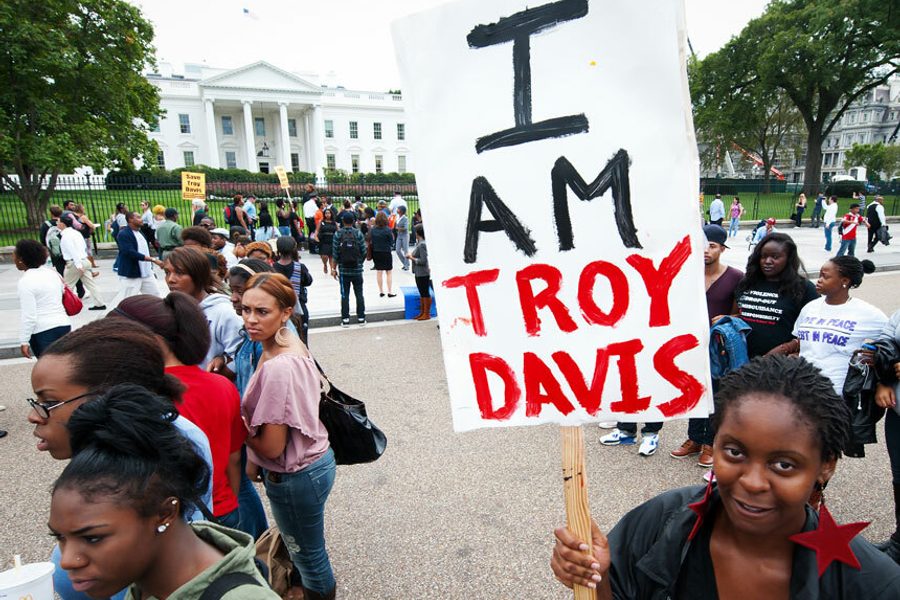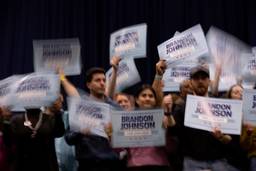The Execution That Birthed a Movement
Troy Davis’ death on Sept. 21, 2011, transformed Occupy and kindled Black Lives Matter.
Jen Marlowe and Keeanga-Yamahtta Taylor

Jordan Taylor remembers precisely when Troy Davis was executed. It was 11:08 p.m. on Sept. 21, 2011, less than an hour before Taylor’s 18th birthday.
“I had never heard his name before,” says Taylor, who says he nonetheless attended a rally fellow students at SUNY New Paltz organized for a death row inmate they told him was innocent. On the threshold of adulthood, Taylor’s eyes were opened: The execution of a Black man by the state of Georgia was connected to Black America’s overall subjugation. “This new understanding of what it was to be a young, Black male washed over me,” he says.
Five months later, when Trayvon Martin was killed by vigilante George Zimmerman, Taylor helped organize his campus’s response. “Troy Davis cracked the screen of reality and Trayvon literally shattered it,” he says. While he had initially seen Davis’ case as the outcome of a broken system, he now understood that the system was functioning just as intended. Taylor later became a founding member of Black Lives Matter-Hudson Valley.
The current wave of racial justice organizing is often traced back to Zimmerman’s acquittal, when the slogan “Black Lives Matter” came into being. But for Taylor and many others, it was Troy Davis’ execution that planted the seeds of political consciousness.
Kenneth Foster Jr., an activist previously on Texas’s death row (now serving a life sentence) puts it like this: “ ‘I am Troy Davis’ created a kinship among victims and supporters. ‘I am Trayvon Martin’ and ‘I am Mike Brown’ unified and spread the message that this could happen to anyone. This new awareness fueled Black Lives Matter.”
Davis was sentenced to death in 1991 for the 1989 murder of a white police officer in Savannah, Ga. Despite the absence of physical evidence linking Davis to the murder—and several witnesses who said police coerced them— the state of Georgia doggedly pursued his execution.
As her body was beset with breast cancer, Troy’s sister Martina Davis-Correia led what became an international campaign to save his life. The mobilization was unprecedented for an anti-death penalty case. From France to Peru to Hong Kong, thousands took to the streets. Fifty-one members of Congress, President Jimmy Carter, Pope Benedict XVI and former FBI Director William Sessions appealed for clemency. Hundreds of college students in Washington, D.C., marched on the White House in hopes of appealing to the nation’s first Black president to use his power to stop the execution of an innocent man.
But President Obama and Eric Holder, the first Black U.S. attorney general, said nothing.
“It was heartbreaking,” Taylor says of Obama’s inaction. “I didn’t understand. He’s the president. The president has this platform, and he’s a Black man.” For the first time, Taylor, and many others like him, questioned their faith in Obama.
“People experienced [Troy’s execution] as a failure on every level of government,” says Thenjiwe McHarris, cofounder of the anti-racist, anti-police violence group Blackbird.
Though there were those (including McHarris) who were never under the illusion that putting a Black person in the White House could eradicate white supremacy, many Black folks had hoped Obama’s election would help. To them, Davis’ execution delivered a painful but eye-opening message: Even under a Black president, Black lives still didn’t matter.
“It got a lot of us more enraged, because even with a Black president this stuff still happened. That was an impetus for a lot of organizing energy,” says Cherrell Brown, 27, a community organizer who also works for the African American Policy Forum at Columbia Law School.
Davis’ execution not only prompted protests against racism and injustice throughout the criminal justice system, but also helped catalyze the emergent Occupy movement. On the night of Davis’ execution, McHarris and others organized a group of his supporters at St. Mary’s Church in Harlem. Simultaneously, Occupiers who had just begun camping at Zuccotti Park in lower Manhattan held a vigil for Davis, using the “people’s mic” to amplify a message Davis had given Amnesty International USA the previous day: “The struggle for justice doesn’t end with me. This struggle is for all the Troy Davises who came before me and all the ones who will come after me.”
On September 22, the night after the execution, hundreds gathered at Union Square for a Day of Outrage for Troy Davis. The marchers, chanting “We Are All Troy Davis!” merged with Occupiers.
That night, for the first time, police attacked Occupiers at Zuccotti Park, pushing demonstrators to the ground and arresting six.
This experience drew attention and support to the nascent movement, as well as sharpening its analysis. “Before the Troy Davis execution, I feel like Occupy had a completely different dynamic,” says brandon king, a member of the Malcolm X Grassroots Movement who was arrested that night. In the aftermath of the execution, says king, “the conversation about police violence and militarism became more apparent.” Several weeks later, more than 30 protesters were arrested in New York at an Occupy Wall Street-backed protest against stop and frisk. Meanwhile, Occupy protests continued to pop up steadily in cities nationwide, resuscitating civil disobedience and militant protest.
On Feb. 26, 2012, five months after Davis’ execution and the start of Occupy, Trayvon Martin was shot and killed by George Zimmerman. “On the heels of Davis’ killing came another visible case of a teen who was criminalized and killed because of his Blackness,” says McHarris.
In the wake of Martin’s killing, thousands of people across the country took to the streets, with word of the protests spreading rapidly online. Activists occupying Florida’s capitol building after Martin’s killing posted real-time updates on Twitter and Facebook.
Social media allowed activists to circumvent mainstream media that either downplayed the activism or ignored it altogether. It also allowed ordinary people to remain connected to events long after the news cameras stopped rolling. “[With Troy], people realized we could use [social media] to get a message out. With Trayvon, that potential was fully realized,” says Cherrell Brown.
Brown was a college senior when Troy Davis was executed. Though she had organized efforts to educate students about Davis’ case on her North Carolina campus, she felt that she hadn’t done enough. Three years later, she watched from her Washington Heights apartment as hundreds took to the streets of Ferguson. “I remembered how it felt to not be able to do anything in Troy’s case,” she says. So she set up a crowd funding campaign to purchase a plane ticket to Missouri. Upon arrival, she connected with the Organization for Black Struggle, a St. Louis-based group involved in the Ferguson protests. “I didn’t know this resistance was possible,” Brown says of the protests. “It was beautiful to witness.”
It’s no coincidence that organizers involved in Davis’ case, including McHarris, played an instrumental role in developing the August 2016 policy platform of the Movement for Black Lives, a collective of more than 50 racial-justice organizations across the country. The platform includes a call to end executions.
“Troy’s execution had an impact on folks,” says McHarris. “A world that honors Black life, Black joy, Black resilience — it cannot be one that includes the death penalty.”
Beyond this call, says McHarris, the core of the Black Lives Matter movement is honoring the resilience and strength of those who fight for their loved ones. As inspiration, she points to the tireless advocacy of Davis’ sister Martina Davis-Correia. Human rights activists worldwide mourned when, two months after Davis’ execution, Davis-Correia passed away.
“She fought so hard. She taught so many people what resistance really looks like and what it means to love somebody,” says McHarris. “Those fighting to prevent injustices, like Troy’s [family], and those who fight after their loved ones have been taken from them: That love sits at the heart of any movement for liberation. It’s certainly at the heart of this one.”





